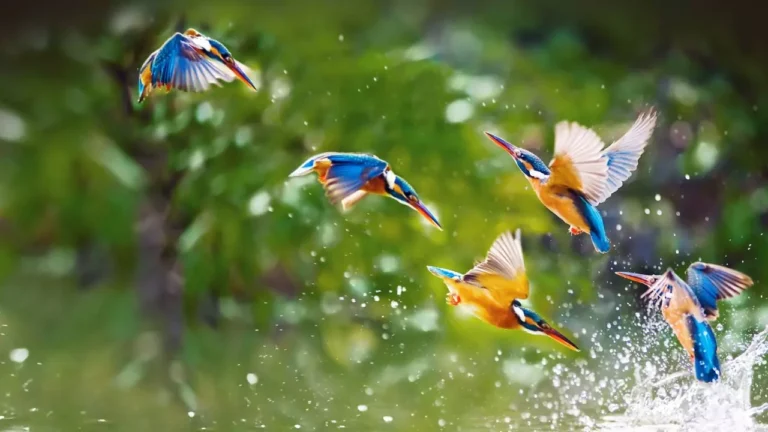Jamaica’s national bird is a unique species of hummingbird that is only found in this Caribbean nation and it is known as the Doctor Bird. This bird has the ability to fly backward and its appearance is indeed fascinating.
So, let’s get to know more about the bird’s looks, origin, habitat, and diet and what makes it a national treasure of Jamaica.
What is The Doctor’s Bird?
The Doctor’s Bird is a unique variety of hummingbird that is exclusively found in Jamaica, and they are also known as the Red-billed Streamertail. It has an outstanding appearance and the male bird is about 4.5 inches when measured without streamers, and with the streamers, they can reach a height of 10 inches in length.
The bird has a vibrant green-colored body with a black crown and tail. It has a red colored bill, with a black colored tip. Comparatively, the female hummingbird is smaller and also does not have the streamers.
The female has a short tail with a clear tip, and the entire body is pale in color, including the back, neck, and crown. The male bird weighs around 7 grams whereas the female is around 6 grams, being lightweight, they can hover over the flowers for nectar. The Doctor’s Bird is also a symbol of the biodiversity of Jamaica.
History of the Doctor’s Bird
The Doctor’s bird was first recognized in 1731 by Mark Catesby, an English naturalist when he was visiting Jamaica. The bird’s presence is highly intertwined with the history, culture, and identity of the country. The bird can be found in different forms of artistic expression and is also used for promoting tourism. It is a symbol of national pride and unity. The bird represents the Jamaican spirit as it has a lively personality, and shows signs of adaptability and resilience.
Why is this Variant of Hummingbird Called The Doctor’s Bird?
There are multiple theories and stories related to the naming of the hummingbird “The Doctor’s Bird”, such as:
Theory 1
The bird has a black crown and long streamers which resemble the hat and coat worn typically by a doctor.
Theory 2
The bird has a long bill, which is used to extract the pollen and it is similar to the syringe used by doctors.
Theory 3
The bird’s name is associated with a traditional tobacco plant found in this region which is used by the Taino shamans. They are the indigenous people of Jamaica, the plants fulfill all the medicinal purposes and so the bird is called Doctor.
Theory 4
Based on the belief of the Taino Indians, the hummingbird has magical power, and it is a reincarnation of the dead, so also referred to as God Bird. There is also a folk song associated with the bird “Doctor Bud a cunny bud, hard bud fe dead”, which means “It is a clever bird which cannot be easily killed”.
Where Are These Doctor’s Birds Found?
The Doctor’s Bird or hummingbird is mostly seen deep inside the forest, around flowering plants. They are also spotted around parks, gardens, and any place that has diverse plants. There are places in Jamaica that have many tourist attraction spots, especially The Doctor’s Bird, such as Barney’s Hummingbird Garden and the Rockland Bird Sanctuary, where a birdwatcher can easily spot a bird. The Doctor’s Bird makes a distinct call with a high-pitched “tee tee tee” and a loud and sharp shriek and so can be easily identified.
What is the Primary Diet of the Doctor’s Bird?
The Doctor’s Bird or humming primarily depends on nectar from the flowers and highly scented shrubs, herbs, and trees for their food. They have a straw-like tongue which helps them to suck or extract the nectars from the plants. They also feed on dead insects, and spiders which add to their protein source. These birds can also have sugar supplements from the hummingbird feeder, installed by the humans. Being diurnal birds, they are active during the day, looking for food and rest during the night. Most importantly, their feeding habits make them an important pollinators in Jamaica.
What is the Present Status of The Doctor’s Bird?
The Doctor’s bird is at present listed as an endangered species, so there is a high risk of extinction due to various factors. This bird species has been going through a rapid decline in population over the past few years. The major threat faced by the Doctor’s bird is habitat loss and fragmentation.
Human activities, such as deforestation, urbanization, and agricultural practices are all responsible for the alarming reduction of the Doctor’s bird, as their natural habitat and forest are being destroyed, which affects their feeding, nesting, and protection behavior.
There is also the risk of inbreeding which leads to thinning of egg shells and eventually, the chick dies after being hatched. As the forests are getting fragmented, the birds are unable to move freely or go out to look for mates, which reduces genetic diversity, and the population’s long-term viability gets compromised.
What Efforts Have Been Made to Protect The Doctor’s Bird?
To protect the Doctor’s bird population from declining, steps have been taken by conservation organizations and government agencies. They are trying to spread awareness, enforce legislation, and take steps against illegal trade. The local communities are also coming up to take measures that would safeguard the bird’s natural habitat. Protected areas have also been established to ensure that the birds can thrive in their natural environment.




